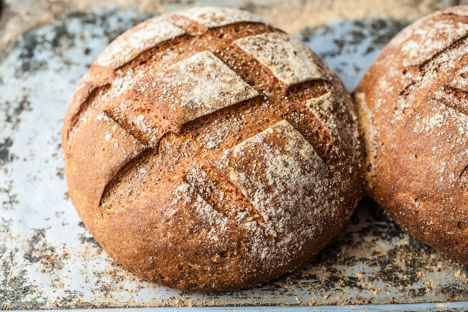
6 of the best baking recipes that showcase ancient grains
Modern wheat is what’s used in the vast majority of baking, but more of us are turning to different varieties that offer exciting new flavours and textures. Try one of these recipes and discover ancient grains.
6 of the best baking recipes that showcase ancient grains
Modern wheat is what’s used in the vast majority of baking, but more of us are turning to different varieties that offer exciting new flavours and textures. Try one of these recipes and discover ancient grains.
There’s nothing quite like opening the oven door to reveal a beautiful loaf of bread, stunning tart or showstopping cake after a day of baking. It’s the perfect combination of science and craft, marrying perfect ingredient ratios with intuition and the senses to create something that’s so much more than the sum of its parts. That’s why the UK has been a proud baking nation for centuries, turning out all manner of delicious sweet and savoury treats which all rely on one simple ingredient: flour.
But not all flour is the same. While most of us reach for the bag of plain flour when baking, in recent years a plethora of exciting new varieties have appeared on shop shelves. The most interesting of these have also been wheat flours, but showcase the ‘ancient’ varieties that were muscled out when modern wheat became the crop of choice among arable farmers. Until then, people were baking with flour made from the likes of spelt, rye, Khorasan, emmer and einkorn as far back as 6000 BCE.
Whether you’ve already been converted to the joys of working with these ancient grains or you’ve never heard of some of them before, there’s never been a better time to get to grips with these fascinating flours. From simple flatbreads to slow-fermented loaves and sweet tarts that make the most of the stronger flavours ancient grains can provide, these six recipes are well worth setting aside some time for.
1. Khorasan flour ciabatta
Ciabatta is one of those great all-rounder breads. It's made with a simple list of ingredients, quicker to prepare than sourdough and versatile enough to be stuffed with meats and cheeses for paninis, toasted and topped with fresh tomatoes or simply torn into chunks and dipped in olive oil. This recipe adds Khorasan (also known as Kamut) flour to the mix; an ancient variety of wheat thought to have been used in ancient Egypt. The slightly nutty flavour lends the loaves a subtle change in flavour, but what’s most interesting is the difference in texture – it gives the crumb an almost buttery quality that you don’t get with modern wheat.
2. Wholemeal spelt English muffins
Add a home-baked English muffin to a breakfast spread and you’ve got an instant hit on your hands – no other bake seems to complement eggs and bacon better. Swapping the plain flour for spelt flour gives them a huge point of difference, replacing the light, sweet, almost cakey taste in favour of something nuttier and more savoury. Easy to make and seriously impressive, these little muffins are a perfect way to get to grips with the benefits of baking with spelt flour.
3. Khorasan dinner rolls
We’ve already extolled the virtues of Khorasan flour and how it adds a buttery texture to bread with our ciabatta recipe, but here it’s bolstered with plenty of oil, garlic and herbs for a fantastic loaf that will fill your kitchen with irresistible aromas. The shape is achieved by rolling out lots of little buns, then placing them into a dish only just big enough to fit them. As they expand during proving and baking, they fuse into one single loaf, ready to be pulled apart again by lots of hungry hands. Perfect for feeding a crowd.
4. Spelt and rye flatbread
These crisp, thin flatbreads have a distinctly Scandinavian feel to them and are the perfect accompaniment to a cheeseboard. There’s no standard wheat flour in them at all; instead, they’re made with a mixture of rye and spelt flour, which gives them a strong nutty flavour that could stand up to even the strongest of cheddars. While they do require a short twenty minute rest to allow the yeast to activate, they can be made from start to finish in one hour – perfect if you suddenly realise you’ve run out of crackers just before your dinner guests start to arrive.
5. Dark rye bread
Rye flour comes in two grades – regular and dark – both of which have their own characteristics. This rye bread showcases the nutty, deep, almost caramel flavour of dark rye, which is used alongside regular flour for a fantastic loaf that marries a complex crumb with a much more distinct and standout taste. It does require making a starter twenty-four hours beforehand, but the end result is well worth it.
6. Cobnut and apple tart
Ancient grains are generally thought of in a savoury context, as they tend to have stronger flavours. However, pastries and enriched breads can really benefit from their more complex taste, especially if you’re after a deeper, nuttier flavour than you get from standard flour. This cobnut and apple tart uses spelt flour to make a simple pastry that complements the fruit and nuts beautifully. If cobnuts aren’t in season, hazelnuts are an excellent substitute.


